Maximizing Aesthetic and Functionality in Studio Spaces
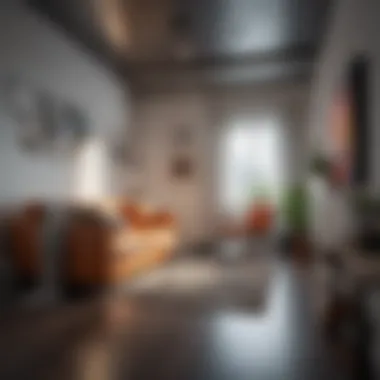
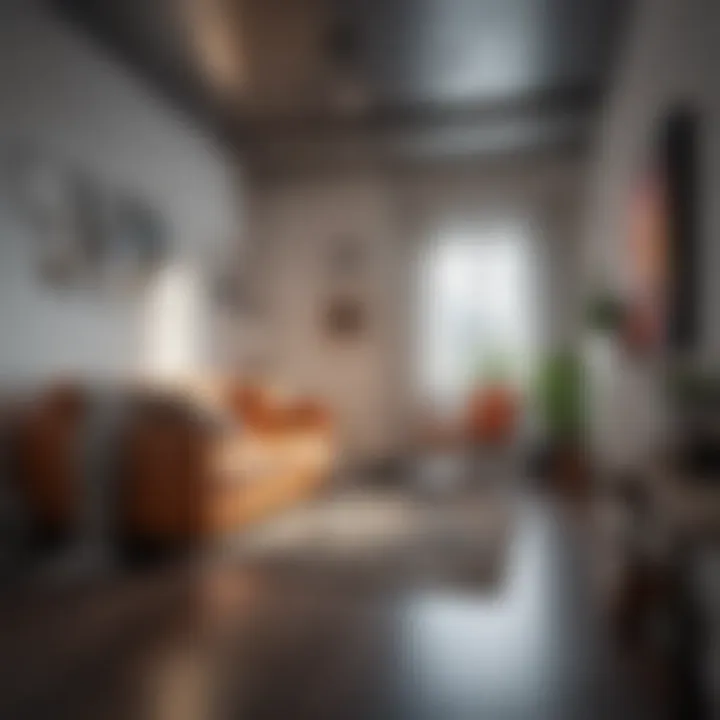
Intro
Studio living spaces are rapidly gaining traction in urban settings, particularly for their ability to harmonize functionality and creativity. Compact yet versatile, these units often become sanctuaries that embody the essence of minimalist living while inviting personal style. Understanding the elements that bring out their potential is crucial for homeowners and design enthusiasts alike.
The creation and adaptation of studio living environments pose unique challenges and opportunities. The allure of these spaces goes beyond just saving on rent or mortgage; they present a canvas for innovative design and resourceful living, making them ideal for modern lifestyles. The section to follow will explore the key home features that define studio living, the artistic inspirations behind interior design, and how these factors intertwine to optimize comfort and aesthetics.
As we navigate through the nuances of studio living, keep in mind the bigger picture—how this trend impacts urban living and reflects a broader shift towards sustainable practices.
Home Features
Architectural Marvels
Studio apartments are often characterized by their open layouts and ingenious use of limited square footage. Consider, for instance, how a well-placed window or a vaulted ceiling can create an illusion of expansive space. Traditional walls can be swapped out for sliding doors or even curtains, allowing for flexibility in functionality.
In cities like New York or Tokyo, where space is at a premium, architects are employing innovative designs that showcase movement and flow. These architectural marvels can make you feel like you are part of a dynamic environment, enhancing both functionality and aesthetics.
- Large windows that allow natural light to flood in are a staple.
- Multi-functional furniture, such as sofa beds or expandable tables, maximizes usability without cluttering.
- Innovative built-in storage solutions, like under-bed storage or wall-mounted shelves, help keep living spaces tidy.
Unique Design Elements
When it comes to making a studio truly sing, the unique design elements come into play. Personal touches can set a studio apart from the rest; think statement art pieces, eclectic decor, or a bold accent wall.
To illustrate, the integration of layering textures—like soft rugs on hardwood floors, or metal accents against neutral backgrounds—can create an inviting atmosphere without overwhelming the senses. Here are a few design ideas:
- Mix natural materials, such as wood and stone, for a warm touch.
- Use mirrors strategically to expand visual space—in tight spots, every trick counts.
- Choose a cohesive color palette, but incorporate pops of color to maintain interest.
"The beauty of studio living lies in the careful attention to detail; it's where minimalism meets personal expression."
Interior Design Inspirations
Color Palettes and Themes
Selecting the right color palette can dramatically shift the feel of a studio apartment. Soft, neutral shades, such as beige or light gray, can help make a space feel more expansive, while bolder hues, like navy or emerald green, can create coziness and warmth.
To make the most of color themes, consider:
- Monochromatic schemes that create a sense of serenity
- Contrasting colors that energize and enliven the atmosphere
- The use of painted accent walls to delineate separate zones within the open layout
Furniture Arrangement Tips
Smart furniture arrangement is vital in a studio, as it can dictate how well the space works for daily life. It’s all about balancing comfort and functionality.
Start by defining distinct areas for different activities:
- Place the bed near a window, if privacy allows, to wake up to natural light.
- Use rugs to delineate spaces—like a small area rug in the living section to signal its purpose.
- Angle furniture slightly to create a more inviting layout that encourages movement and conversation.
The exploration does not stop here; it leads us to the broader implications of studio living, touching on how these small spaces influence urban dynamics and sustainable practices.
Understanding Studio Living Spaces
In the era of shrinking urban footprints and escalating living costs, studio living spaces have surged in popularity. These compact environments are not just a housing choice, but rather a lifestyle statement. They bring forth a blend of practicality and creativity, making them notable in discussions about modern living. Understanding studio living spaces is imperative for realizing how to fully harness their potential.
Studio apartments charm with their essence of simplicity and versatility. Residents can maximize their limited square footage in ways that traditional homes cannot accommodate. The essence of a studio lies in the fusion of living, sleeping, and working areas, often with minimal separation. When you start to peel back the layers of studio living, you uncover numerous benefits and considerations that inform how these spaces can be personalized and optimized.
Definition and Characteristics
A studio apartment can be defined as a self-contained unit that combines a bedroom, living room, and kitchen into one open space, leaving little room for privacy. Typically, these spaces range from 300 to 600 square feet, although size can vary significantly based on location and building standards.
Key characteristics include:
- Open Layout: Unlike one-bedroom apartments, studios lack designated rooms, fostering a seamless flow from one area to another.
- Functional Design: With limited space, studios require well-thought-out designs that prioritize functionality and sophistication. This often involves clever, modular furniture that adapts to multiple uses.
- Economical Living: On a practical level, studio apartments are typically more affordable than larger units, making them a wise choice for students, young professionals, and those looking to downsize.
‘In many ways, studio living mirrors the urban experience itself—dense, dynamic, and ever-changing.’
Evolution of Studio Apartments

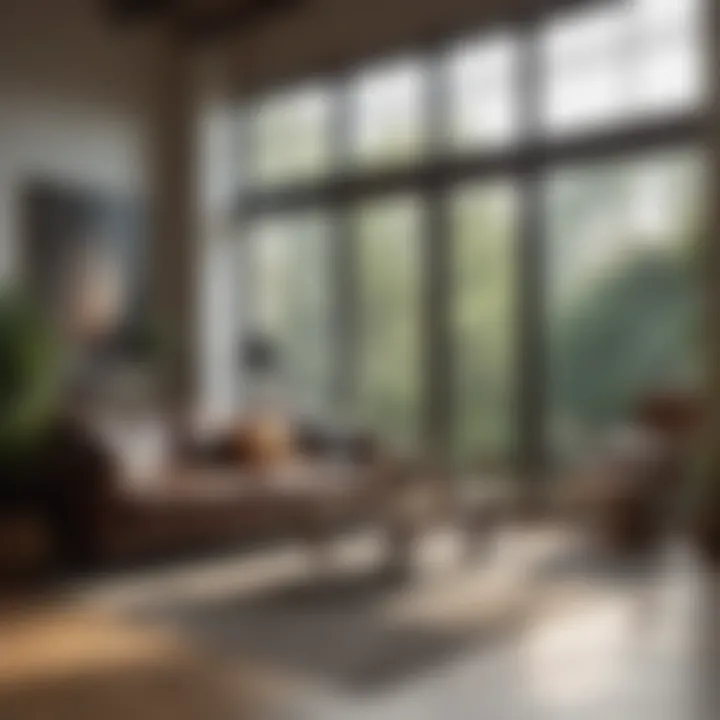
The concept of studio apartments isn’t a new fad; it traces its roots back to the early 20th century. Originally designed for artists and other creatives, studios provided the necessary space to live and work without breaking the bank. However, their evolution has seen them transform from mere artistic havens to mainstream housing options.
By the 1950s, the demand for compact living grew as cities expanded and urbanization accelerated. Young individuals flocking to major cities, paired with a rise in social mobility, made studio apartments a viable solution.
Recent trends have highlighted an intriguing shift towards smaller living spaces even in luxury sectors, where studio layouts are cleverly integrated into high-end buildings attracting a discerning clientele. Developers now prioritize open spaces paired with smart technology, embracing minimalism alongside functionality.
In understanding studio living spaces, one can grasp how these unique apartments not only anchor personal lifestyles but also reflect larger societal changes towards urban density and sustainability.
Design Principles for Studio Spaces
Understanding the design principles behind studio spaces is pivotal for anyone who wishes to call such a compact dwelling home. Designing these areas effectively allows for the maximization of every square foot, ensuring functionality while also creating an aesthetically pleasing environment. These principles are not just about making things fit but are about creative solutions that resonate with the lifestyles of individuals. Embracing these design guidelines can transform studio living from merely functional to genuinely enjoyable.
Maximizing Space Efficiency
When it comes to maximizing space efficiency in a studio apartment, thinking outside the box is key. Traditional notions about rooms and layouts need to be redefined. One approach is the use of open shelving instead of bulky cabinets; it not only provides storage but also keeps the space looking airy. Consider experimenting with vertical space—mounting hooks for kitchen utensils can clear kitchen counters.
A significant strategy is to adopt a minimalist philosophy. Here, the principle of ‘less is more’ shines. If possessions are trimmed down to essentials, there’s more room to breathe in the studio. Use dual-purpose items, such as a coffee table that doubles as a storage unit, to clear up floor space and maintain a more open atmosphere. Think about furniture arrangement, too; placing larger furniture pieces against the walls can open up central areas, fostering a more spacious feel.
Color Schemes and Lighting
Color schemes and lighting play a crucial role in defining the mood and perceived size of the studio. Light colors tend to reflect more light, making a small space feel larger. Soft whites and pastel hues can act as a backdrop for personality. But don’t shy away from bold splashes either; an accent wall can create interest and visual depth.
In terms of lighting, the importance of natural light can’t be overstated. Using sheer curtains can invite sunlight, while strategically placing mirrors can bounce that light around, enhancing brightness. Alternatively, layered lighting is essential for versatility. Combining ambient, task, and accent lighting can create different moods throughout the day. Imagine cozy evenings made cozier with soft, warm light, contrasted by bright, focused task lighting for those activities that require more attention.
Furniture Selection and Arrangement
Furniture selection in studio spaces can feel like finding a needle in a haystack, but it needn’t be that challenging. Opt for multipurpose furniture; a sofa that converts to a bed or an ottoman that hides items can be game changers. When arranging furniture, consider flow—ensuring that paths between areas are unobstructed allows for ease of movement, which is especially important in a compact space.
It’s crucial to scale furniture appropriately. A colossal sectional can overpower a small area, leading to feelings of claustrophobia. Instead, choose smaller scale items that complement the overall design without being overpowering. Arrangements like floating furniture, where seating areas are defined away from walls, can create distinct zones while retaining an open feel.
Decorating studio apartments is about finding a balance between style and practicality. It is an ongoing exploration into how you can live comfortably within a smaller footprint. By embracing space efficiency, thoughtful color choices, and smart furniture strategies, it is indeed possible to create a home that reflects personality and meets practical needs.
Functional Areas in Studio Living
When considering studio living, understanding the functional areas is crucial. This concept delineates the space into various zones, making small, often cramped quarters feel purposeful and organized. A well-defined layout can transform a studio from just a sleeping area to a multi-faceted living environment. Without clear functional areas, residents may find themselves navigating a chaotic space, resulting in stress or frustration.
To effectively optimize these areas, homeowners should think about the specific functions they need to accommodate in their living space. Here are some common functional areas often found in studio homes:
- Sleeping Area: This is the area designated for rest. It should be inviting and comfortable, often featuring a bed, nightstands, and possibly a wardrobe.
- Living Room: A space for relaxation, entertainment, or socializing. This area typically includes seating arrangements, a coffee table, and sometimes a console for media devices.
- Kitchenette: A compact cooking space may include a small fridge, a microwave, and possibly a stove. Convenient access to kitchen appliances is important for daily living.
- Workspace: In today’s remote working culture, many studios incorporate a small desk or work corner that allows for productivity without a dedicated office.
- Bathroom: Essential for privacy and hygiene, studio residents must consider the layout of their bathrooms, ensuring ease of access from all functional areas.
By clearly categorizing these functional areas, residents can better manage their belongings, streamline their daily routines, and create a more satisfying living experience.
Creating Distinct Zones
Creating distinct zones in a studio allows for the optimization of the limited space available. This practice is about more than just aesthetics; zoning can enhance functionality and accessibility.
One popular method is using furniture placement as a way to divide space. For instance, a sofa can face away from the bed, naturally creating a boundary between the living area and sleeping quarters. Bookshelves or room dividers can also work wonders to distinguish these areas without adding clutter.
Additionally, color schemes and visual cues can further delineate zones. Perhaps a warm, inviting color in the sleeping area to instill calmness and a more vibrant color for the workspace to boost creativity. Utilizing different rugs for various areas not only offers functionality by designating spaces but can add texture and depth to the overall aesthetic.
Implementing zones provides benefits such as:
- Better focus and productivity in designated work areas.
- A sense of privacy, even in a shared or compact environment.
- A more orderly living situation, as residents know where things belong.
Simply put, functional zoning affords a greater quality of life in studio living.
Incorporating Multi-functional Furniture
In small living spaces like studios, multi-functional furniture is a game changer. Furniture that serves dual purposes can effectively maximize square footage and combine several needs into one piece.
For example, a Murphy bed folds up into the wall when not in use, freeing up floor space for daily activities. Ottomans with built-in storage can double as extra seating while allowing for the storage of blankets or miscellaneous items that may clutter your space. Similarly, a dining table that can convert into a workspace is invaluable—two birds with one stone, they say.
Here are some considerations when selecting multi-functional furniture:
- Sizing: Measure your space first to ensure a good fit without overcrowding.
- Ease of Use: Choose pieces that are simple to transform. Complicated mechanisms can negate the benefits of dual functionality.
- Quality and Durability: Investing in quality materials can extend the life of the furniture. Avoid flimsy options that won’t withstand regular use.
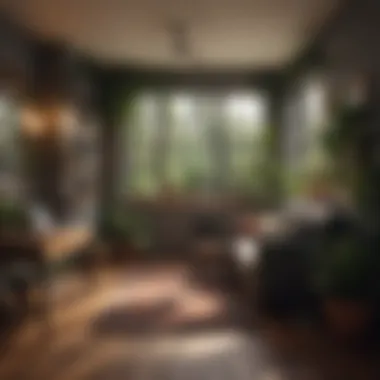
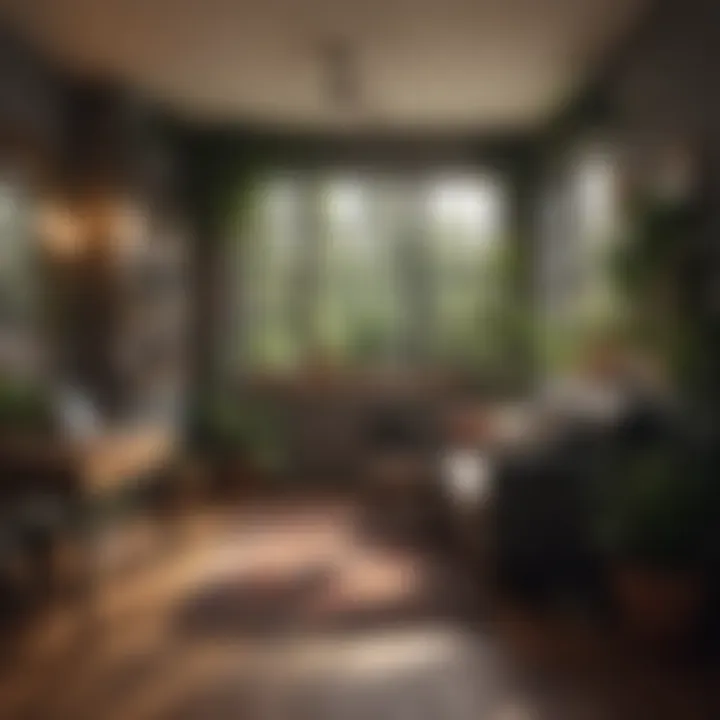
Incorporating such furniture allows individuals to fluidly navigate their spaces without feeling constrained, lending a hand in creating a balance between style and utility.
"In studio living, every piece counts. Opt for functionality without sacrificing your personal style."
Ultimately, the right furniture can enhance your living space, leading to a more enjoyable daily life.
Personalizing Studio Spaces
Personalizing a studio space is not just about adding a personal touch; it's about creating an environment that reflects your personality and lifestyle. The importance of personalization in studio living cannot be overstated. In a compact area where every square foot counts, personal elements can transform what might seem like a standard space into a cozy sanctuary that resonates with comfort and belonging.
One of the intriguing aspects of studio living is how it invites inhabitants to rethink their relationship with belongings and aesthetics. The idea of personalization goes beyond mere decoration; it involves selecting items that serve a functional purpose while also mirroring one's tastes. The choices one makes can range from vibrant accent colors that energize a corner to minimalistic objects that promote a serene atmosphere. Whatever the direction might be, it's pivotal that each piece speaks to the occupant’s identity.
Infusing Personal Style
Infusing personal style into a studio apartment can be approached in various ways. First, consider the color palette. Colors have profound impacts on mood and perception. Bright yellows and deep reds may exhilarate and evoke creativity, while soft blues and greens can bring about calm and relaxation. That decision alone can set the stage for the entire atmosphere.
- Textiles: Your choice of textiles, like throw pillows, curtains, or rugs, can drastically change how a studio feels. Cozy materials invite comfort, encouraging relaxation after a long day.
- Arrangement: How you arrange furniture can also convey personal style. An open layout encourages social interaction, while a more segmented setup can promote privacy and focus.
Additionally, think about integrating items that tell a story. Perhaps a vintage chair inherited from a grandparent or a framed travel photograph speaks volumes about your history and experiences. These personal artifacts become conversation starters, adding depth to the living environment.
The Role of Art and Decor
Art and decor contribute significantly to the overall feel of a studio. They offer opportunities for self-expression and infuse character into the space. Often, art is more than just visual appeal; it channels emotions and reflects values.
- Wall Art: Portraits, landscapes, or abstract prints can dominate a wall and create focal points. A gallery wall could encompass a mix of framed art, personal photographs, and even shadow boxes displaying cherished keepsakes. This layered approach to decor can add depth and complexity.
- Sculptures and Objects: Three-dimensional pieces, whether they're locally sourced ceramics or a globe acquired on travels, add texture and intrigue. They often invite a tactile experience, breaking the flatness that can sometimes characterize smaller areas.
"Art is not what you see, but what you make others see." — Edgar Degas
Overall, blending your personal style with meaningful decor can elevate a studio from ordinary to extraordinary, showcasing not just your taste, but also your journey. It's an exciting challenge to tailor a space uniquely suited to you, promoting both aesthetics and functionality in one harmonious entity.
Sustainability in Studio Living
In a world increasingly aware of its environmental footprint, sustainability in studio living takes on special significance. Studio apartments, often seen as the epitome of urban convenience and efficiency, can also be a beacon for sustainable living. By embracing eco-friendly materials and modern technology, individuals can transition into comfortable living spaces that align with the greater goal of conserving resources.
Adopting a sustainable approach is not just about reducing waste; it’s about enhancing quality of life. Small living spaces like studios prompt a thoughtful consideration of what really matters - both in design and in lifestyle. Integrating sustainable practices can lead to reduced environmental impact and even lower living costs.
Eco-friendly Materials and Solutions
When we talk about eco-friendly materials, it's essential to understand what qualifies as such. Materials like bamboo, reclaimed wood, and recycled metal are not just trendy; they embody a philosophy of reducing the depletion of natural resources. For instance, using reclaimed wood for shelving not only imparts character but also diminishes the need for new timber, which is often harvested unsustainably.
Furthermore, choosing low-VOC (volatile organic compounds) paints enhances indoor air quality, making your studio a healthier place to live. Certain brands, such as Benjamin Moore's Natura line, provide a vast array of beautiful colors without the harmful chemicals typical in traditional paints.
The implementation of energy-efficient appliances can significantly impact your studio's sustainability credentials. Opting for ENERGY STAR-rated appliances helps to minimize energy use, translating to lower utility bills while reducing carbon emissions.
Energy Efficiency and Smart Technology
Energy efficiency forms the backbone of sustainable studio living. Embracing capacities of smart technology further propels studios toward eco-friendly goals. Systems that allow residents to control heating, cooling, and lighting through smartphone applications can markedly decrease energy consumption.
For example, smart thermostats, such as the Nest Learning Thermostat, learn your habits over time, adjusting the temperature automatically to save energy when you're not home. This not only benefits the environment but also eases the financial burden by optimizing energy consumption.
Regarding lighting, utilizing LED bulbs instead of traditional incandescent ones can lead to drastic reductions in electricity usage. LEDs consume about 75% less energy and last up to 25 times longer, a change that reflects both economic and ecological sensibilities.
"Sustainable living is not a destination but a journey, one that includes evaluating our choices, from the materials we use in our homes to the technology we adopt."
As more urban dwellers seek simplicity without contributing to excess waste, the movement towards sustainability in studio living will only grow. With thoughtful design choices and a clear commitment to eco-friendly practices, studio homes can reflect a balance between comfort and environmental stewardship, proving that small spaces can have a big impact.
Challenges of Studio Living
Living in a studio can feel like walking a tightrope. While these compact spaces offer a unique charm and an urban lifestyle that's hard to beat, they come with their own set of hurdles that residents must navigate. Understanding these challenges is crucial not only for those who already reside in studio apartments but also for potential buyers, designers, and anyone considering a shift to this lifestyle. Let's dive into a couple of these significant challenges: storage issues and privacy concerns.
Storage Solutions
In the world of studio living, space is both a gift and a curse. Without designated rooms, residents are often pressed to find innovative storage solutions. Imagine trying to squeeze a lifetime's worth of belongings into a single room. It's like trying to fit a square peg in a round hole; frustrating and sometimes seemingly impossible.
Here are some practical solutions:
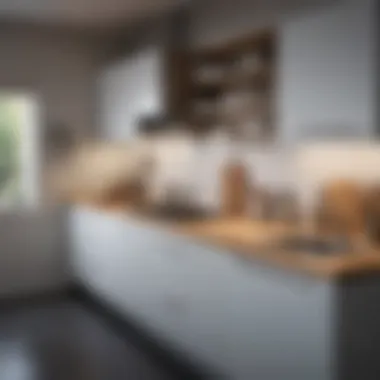
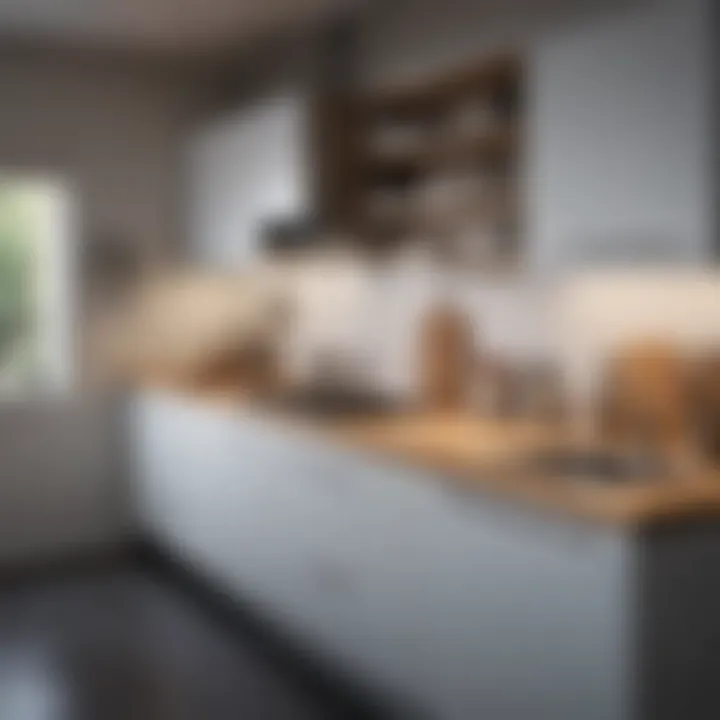
- Vertical Space: Utilizing the walls can be a game changer. Tall shelves, wall-mounted racks, and hooks can provide ample storage without eating up floor space.
- Convertible Furniture: Think of a coffee table that unfolds into a dining table or a bed that hides away in a wall. This type of furniture transforms a space, making it functional at various times of the day.
- Hidden Storage: Ottomans, benches, and beds with drawers can help keep everyday clutter at bay. These unassuming pieces often carry more than meets the eye.
- Baskets and Bins: Stylish storage bins can add a touch of decor while providing a place to tuck away odds and ends. No one will know your secrets are hidden in there if they look good!
Adopting these strategies not only maximizes the space but also enhances the functionality of the studio itself, enabling occupants to thrive in this somewhat confined environment.
Privacy Concerns
Ah, the delicate dance of privacy in a studio. Living in such close quarters can feel like being on a never-ending stage, where every move is potentially on display. Especially for couples or roommates, defining personal space can become a battle.
Consider these points:
- Sound Barriers: Simply put, noise carries. A conversation in the living area can easily spill into the sleeping nook. Using rugs, curtains, and upholstered furniture can absorb some of that sound, creating a more serene environment.
- Visual Screens: Room dividers can be a useful tool. Whether a folding screen or a decorative bookcase, these can create the illusion of separate spaces, offering a semblance of privacy.
- Personal Boundaries: Establishing guidelines for quiet hours or shared areas helps reduce friction between cohabitating individuals. It’s also helpful to have designated areas for personal belongings.
Navigating privacy in a studio isn’t about walling oneself off but finding a balance that allows for both togetherness and solitude when needed.
"The key to studio living is not merely about compromising space, but optimizing how it functions for you."
The Impact of Urbanization on Studio Living
Urbanization has dramatically shaped the way we think about and engage with our living spaces, particularly in densely populated areas. The dynamics of studio living have evolved in response to this trend, making it essential to understand how urban growth influences the design, functionality, and overall appeal of these spaces. While studio apartments are often seen as solutions to space constraints, their development has broader implications for urban living, optimizing limited resources while fostering a sense of community.
Trends in Urban Living
One cannot overlook the shift in urban living trends over the past few decades. Increasing migration to cities has led to a surge in demand for housing. Studio apartments emerge as a practical choice for young professionals, artists, and those who seek an urban lifestyle but may not have hefty budgets. These compact living spaces serve not only as homes but also reflect the values of modern city dwellers who prioritize conveience and experiences over material excess.
In many cases, minimalism becomes a guiding principle. With folks trading in oversized homes for smaller studios, concepts such as tiny living and multifunctional furniture gain momentum. Importantly, urban living trends often encourage innovative designs that maximize space and improve quality of life.
A few notable trends include:
- Co-living spaces: These arrange studio units around shared facilities, such as kitchens and lounges, reducing costs and fostering community.
- Smart home integrations: With technology advancing, many urban studios incorporate smart devices for efficiency and convenience.
- Sustainable approaches: More people are seeking eco-friendly design options in studio spaces, such as energy-efficient appliances and sustainable materials.
Community and Shared Spaces
The concept of community becomes vital within the framework of studio living, especially in urban environments. With space at a premium, studios are often designed to encourage social interaction among residents. This is achieved through shared areas like rooftop gardens, communal workspaces, or lounges. These spaces allow neighbors to mingle, fostering connections that can feel missing in traditional housing.
Notably, communal areas can greatly influence the resident's experience. A well-designed shared space can transform a solitary lifestyle into one enriched with personal interactions and shared knowledge. Residents may host events, engage in creative collaboration, or simply enjoy a chat over coffee in common areas.
Some key considerations for fostering community in urban studio living include:
- Design of shared spaces: Crafting inviting and functional communal areas can enhance residents' well-being.
- Inclusivity in activities: Organizing regular events or workshops can knit the community closer.
- Digital platforms: Many communities use social media or apps to communicate and stay connected, further enriching interaction among neighbors.
"In a world where connections are often digital, the value of a warm, communal space grows exponentially."
Overall, understanding the impact of urbanization on studio living reveals not just the challenges but also the remarkable opportunities these spaces present. As cities continue to grow and thrive, adapting to the needs of their inhabitants through thoughtful design and community-oriented principles will remain paramount.
Future Trends in Studio Design
In today's fast-paced world, the landscape of studio living is evolving. With urban areas swelling and the concept of minimalism gaining traction, attention turns to the future of studio apartments. These compact spaces are no longer just about fitting in the essentials; they are designed to offer a lifestyle. Understanding the future trends involves recognizing the shift towards innovative layouts, smart technologies, and adapting to new living realities such as remote work. This section digs deep into how these advancements bring both style and function to studio living.
Innovative Layouts and Technologies
As designers grapple with the constraints of limited square footage, they are breaking traditional molds with innovative layouts that optimize every inch.
- Flexible Spaces: Gone are the days when studios simply offered a bed and a kitchenette. The trend leans towards multifunctional zones—think folding walls or movable partitions. This allows for an adaptive use of space where one area can easily morph from living room to office or bedroom.
- Smart Home Technologies: The integration of technology simplifies and enhances daily living. Smart devices, like voice-activated lighting systems and app-controlled thermostats, are becoming standard in studio apartments. These gadgets not only offer convenience but also help residents manage energy consumption more efficiently.
- Virtual and Augmented Reality: Homebuyers and renters now expect to engage with spaces digitally before making decisions. Virtual reality tools allow potential tenants to visualize layouts, and augmented reality apps help them envision changes to the design or furniture arrangement in real-time.
With these trends, the focus is clearly on adaptability and efficiency, making every square foot count.
Adapting to Remote Living
The lockdowns and changes triggered by the pandemic have shifted the way we think about living spaces. Studio apartments are now tailored to meet the needs of remote living.
- Dedicated Work Zones: People are increasingly working from home, and studios are evolving to create specific work areas. Design elements incorporate adaptable desks and noise-canceling panels, ensuring that work and leisure can coexist harmoniously.
- Enhanced Connectivity: As remote work thrives, the demand for high-speed internet connections and solid tech setups increases. Architects and designers now prioritize hard-wiring and broadband compatibility in their designs.
- Wellness Features: Recognizing the need for balance, many future studio designs focus on health and wellness. This includes the incorporation of natural materials, air purifiers, and lighting solutions designed to mimic daylight, encouraging a positive atmosphere conducive to productivity.
Closure
The exploration of studio living spaces encapsulates a blend of creativity and practicality, necessitating a serious reflection on their intrinsic purpose. Understanding why one chooses to inhabit a smaller space can unearth interesting motivations. For many, studio living epitomizes a lifestyle choice rather than merely a housing situation. It fosters a sense of community while promoting a minimalist lifestyle that often leads to a calmer state of mind.
"Reflecting on the essence of studio living is essential; it helps people appreciate the inventive spirit that arises within these environments."
The journey to optimize a studio apartment typically revolves around several critical elements:
- Space Management: In the heart of urban locations, where real estate tends to be pricey, studio living represents a clever solution to high housing costs. Efficient use of every square inch is paramount, which is a skill that, once mastered, can drive creativity.
- Personal Expression: Each studio has the potential to tell a story, depicting the personality of its inhabitants through art, furniture, and decor. Customizing a living space is often more vital than the space itself; it reflects the passions, tastes, and aspirations of those who reside in it.
- Sustainability Considerations: The movement towards ecological awareness has not left studio living untouched. The adoption of sustainable materials and energy-efficient practices is paramount in creating a wholesome living environment.
- Balancing Privacy and Community: Many occupants find solace in the strong sense of community that studio living creates. However, balancing social interactions and personal time poses an ongoing challenge that requires deliberate thought.
In sum, reflecting on the purpose behind studio living unfolds a myriad of considerations—from optimizing space for maximum impact to personalizing it with the owner's unique flair. This article outlines a roadmap for navigating the complexities of studio apartments while making informed choices about style and functionality. Each factor contributes richly to the overall living experience, ensuring that such spaces serve not just as shelter, but as a canvas for self-expression and sustainable living.



